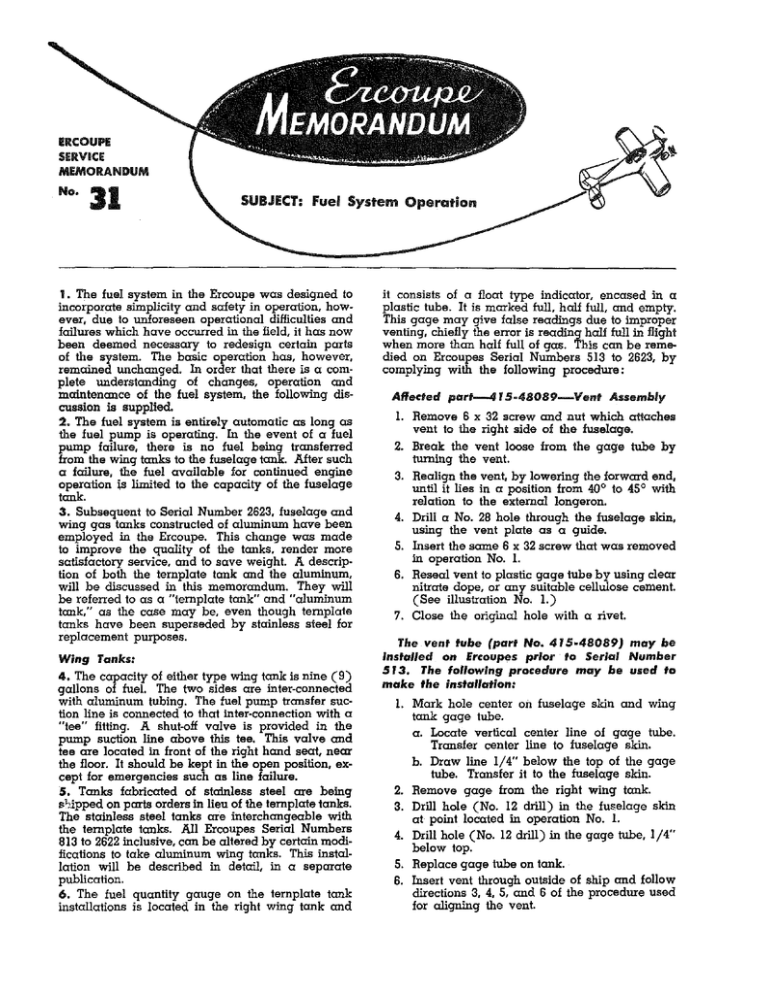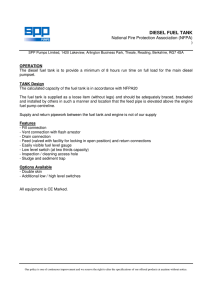SUBJECT: Fuel System Operation
advertisement

ERCOUPE
SERVICE
MEMORANDUM
No.
JJ
SUBJECT: Fuel System Operation
1 • The fuel system in the Ercoupe was designed to
incorporate simplicity and safety in operation, however, due to unforeseen operational difficulties and
failures which have occurred in the field, it has now
been deemed necessary to redesign certain parts
of the system. The basic operation has, however,
remained unchanged. In order that there is a complete understanding of changes, operation and
maintenance of the fuel system, the following discussion is supplied.
2. The fuel system is entirely automatic as long as
the fuel pump is operating. In the event of a fuel
pump failure, there is no fuel being transferred
from the wing tanks to the fuselage tank. After such
a failure, the fuel available for continued engine
operation is limited to the capacity of the fuselage
tank.
3. Subsequent to Serial Number 2623, fuselage and
wing gas tanks constructed of aluminum have been
employed in the Ercoupe. This change was made
to improve the quality of the tanks, render more
satisfactory service, and to save weight. A description of both the template tank and the aluminum,
will be discussed in this memorandum. They will
be referred to as a "template tank" and "aluminum
tank," as the case may be, even though template
tanks have been superseded by stainless steel for
replacement purposes.
Wing Tanks:
4. The capacity of either type wing tank is nine (9)
gallons of fuel. The two sides are inter-connected
with aluminum tubing. The fuel pump transfer suction line is connected to that
inter~connection
with a
"tee" fitting. A shut-off valve is provided in the
pump suction line above this tee. This valve and
tee are located in front of the right hand seat, near
the floor. It should be kept in the open position, except for emergencies such as line failure.
5. Tanks fabricated of stainless steel are being
s'oipped on parts orders in lieu of the template tanks.
The stainless steel tanks are interchangeable with
the template tanks. All Ercoupes Serial Numbers
813 to 2622 inclusive, can be altered by certain modifications to take aluminum wing tanks. This installation will be described in detail, in a separate
publication.
6. The fuel quantity gauge on the template tank
installations is located in the right wing tank and
it consists of a float type indicator, encased in a
plastic tube. It is marked full. half full, and empty.
This gage may give false readings due to improper
venting, chiefly the error is reading half full in flight
when more than half lull of gas. This can be remedied on Ercoupes Serial Numbers 513 to 2623, by
complying with the following procedure:
Affected part-415-48089-Venf Assembly
I. Remove 6 x 32 screw and nut which attaches
vent to the right side of the fuselage.
2. Break the vent loose from the gage tube by
turning the vent.
3. Realign the vent, by lowering the forward end,
until it lies in a position from 40° to 45° with
relation to the external longeron.
4. Drill a No. 28 hole through the fuselage skin,
using the vent plate as a guide.
5. Insert the same 6 x 32 screw that was removed
in operation No. I.
6. Reseal vent to plastic gage tube by using clear
nitrate dope, or any suitable cellulose cement.
(See illustration No. I.)
7. Close the original hole with a rivet.
The vent tube (part No. 415·48089) may be
Installed on Ereoupes prior to Serial Number
513. The following procedure may be used to
make the Installation:
I. Mark hole center on fuselage skin and wing
tank gage tube.
a. Locate vertical center line of gage tube.
Transfer center line to fuselage skin.
b. Draw line 1/4" below the top of the gage
tube. Transfer it to the fuselage skin.
2. Remove gage from the right wing tank.
3. Drill hole (No. 12 drill) in the fuselage skin
at point located in operation No. I.
4. Drill hole (No. 12 drill) in the gage tube, 1/4"
below top.
5. Replace gage tube on tank.
6. Insert vent through outside of ship and follow
directions 3, 4, 5, and 6 of the procedure used
for aligning the vent.
Page 2-MEMORANDUM No. 31
7. The fuel quantity gage in the aluminum wing
tank is different from the one used in the template
tank. The new gage is mechanical and is operated
by a float resting on the surface of the fuel, which
moves a marked dial, showing the amount of fuel
in the tank. This gage is located in the left wing
tank where it extends into the cabin forward of the
seat.
12. The sealing of the cap gasket also affects
proper venting. If difficulty is experienced in attaining a good seal of the gas cap, which is an unmachined casting, the sealing surface may be filed
smooth and the gasket cemented to this surface.
Should there be an excessive amount of solder on
the filler neck sealing surface, it may also be removed by filing.
8. Reports from the field state that these gages can
become inoperative due to the rusting of the working parts in the gage. It is recommended that all
of the new type fuel gages be periodically inspected
and if, after such inspection, the gage is found to
be rusted, it should be replaced or repaired. If the
latter procedure is desirable, the following information is supplied to aid in making repairs.
13. A more suitable gasket. made from a synthetic
rubber "Neoprene" (sponge rubber) will be available soon. The oil sump gage gasket (Continental
Motors Corp. Part No. 22404) has also been found
to provide a satisfactory substitute for our gas tank
cap seal.
I. Remove the gage from the tank, which gage is
held in place by 12 screws, (AN 520-4-S ).
2. Disassemble the gage and remove all of the
rust from the alfected parts.
3. Paint these parts with zinc chromate or spar
varnish, and allow paint to dry thoroughly.
4. Reassemble the gage.
5. Prior to replacing the gage in the tank, remove
all traces of the original sealer, (EC-570, product of the Minn. Mining and Mig. Corp.) from
the parting surfaces of the gage and the tank.
If the original material used for a sealer is not
available, Permatex or similar gasket cement
maybe used.
6. Replace the gage, using some of the sealing
cement to secure screws.
9. It has been the experience of some Ercoupe
owners and operators that line mechanics put the
wing tank caps on backwards. To prevent malfunctioning of the fuel system, it is imperative that
the caps be put on the tanks with the vent hole to
the front. This provides venting of each wing tank
and will prevent syphoning or unequal flow of the
fuel. Unequal flow may result in the fuel pump
being unable to transfer all of the fuel from the
wing tanks to the fuselage tank.
1 0. It is recommended that the wing tank cap be
marked in a manner to indicate proper positioning.
A painted red line on the wing· behind the cap to
match a painted sector on the cap should be used.
The painted sector on the cap should extend from
the point of engagement to the locked position, as
indicated on accompanying sketch No. 2.
11. On Ercoupes subsequent to Serial Number 2623,
the fU!er neck and cap combination is foolproof and
the caps cannot be put on backwards.
14. The capacity of the template fuselage tank is
five gallons; the aluminum fuselage tank will hold
six gallons of fuel. The fuselage template and
aluminum tanks are not interchangeable. However,
stainless steel tanks can be installed in place of the
template fuselage tanks, without modification, and
should be so used. (See Service Policy Letter A-4).
I 5. The line that feeds fuel, by gravity, from the
fuselage tank to the carburetor is connected to the
fuselage tank through a shut-off valve and tank
finger strainer. This valve on the template tank has
a position selector on the instrument panel, whereas
the valve on the aluminum tank may be turned on
or off by reaching under the left side of the instrument panel. This valve is for emergency purposes
and should not be used to shut off the engine.
FUEL PUMP, FILTER, AND PLUMBING:
I 6. The fuel in the wing tanks is transferred to the
fuselage tank by a fuel pump that is mounted on
the engine. A restricted fitting is located on the
outlet side of the fuel pump. and limits the output
of fuel to a quantity slightly in excess of the requirements of full throttle operation.
1 7. A return, or overflow line is provided in the
fuselage tank. This line will return to the wing
tanks any fuel that is pumped into the fuselage tank
in excess of its capacity. Excess fuel is returned to
the right wing tank with the template fuselage
tank and to the left wing tank with the aluminum
fuselage tank.
I 8. A sediment bowl type filter is located in the
gravity fuel feed line. Its function is to accumulate
any water or foreign matter that might otherwise
enter the carburetor. The bowl is detachable for
cleaning. This should be included on the daily inspection sheet. The bowl should be safetied after
cleaning.
£XT£RNAL LONOERON
RELOCATE HOLE
\
I
.,
/
-_./'-"-"
SEAL OLD
HOLe WITH R/V£7
------------,
-~~-
6AS VENT
~:\(-'::/'
H
II
;jt
'I
--
\yi
n
J'
~I----_
~
~~~~':::::::t;;;;;l;;;;;l;;;;;r:;;;;z:::;z;:;;z:;;::z::;;:::;z;J
8 REA K 5£WHEN
AL
(R£-5£AL
ENT
15 INSTALLED
,1
\
il.._.
il
' '- ,
,tJ,
\'
C3AUC3E TUB£
r--r
I I
~
'i-(
\.
\L
""
'
8
~
"
'r ) "
\1
'\ \
,,
I
h)
'-.
LJ"- "-
~
.::ti
::s
\
"
" "'
-- -- --
~~
~
\
lb~
"'u
~·"!
~?;;
~
~
RE-5ETTIN6 GAS VENT
0 OBTAIN PROPER VENT/No
~
'/26/46
1
:;;;:
1::1
~
(/{)
MARK TANK AND CAP, AS
SHOWN; TO A55URE PROPER
PLACEMENT OF CAP
~
9'
0
([)
VENT !tOLE
'
1\)
([)
0
~
8
§
1'ii
~
);)
~
~~
~
~R
l'll'ti
:t~:-;
~~
~
1:)
6AS TANK OETAIL
(SHOW/No MARKINCJS ON TANK ,AND
1
~
~





